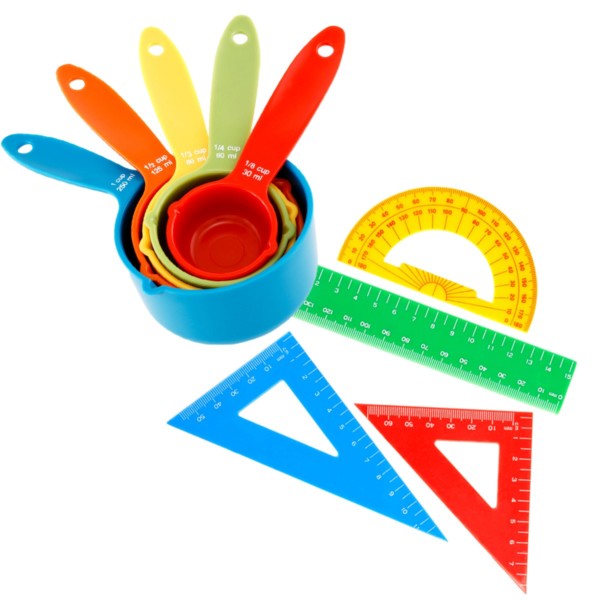The Beauty of Math Patterns: Exploring Mathematical Sequences
Explore the fascinating world of math patterns, from Fibonacci sequences to fractals. Read our blog to learn more.

Introduction
Our instructors at Mathnasium love teaching how math relates to everyday scenarios. That includes the countless ways to measure everyday objects’ fractional values! In this week's word problems, we’ll have your child practice using measurements like weight, cost, or even rotation to find the values of whole or fractional parts!
Go to the next page and read this week’s description with your child. Choose the word problem that’s the right skill level for them and have them give it a try. After they feel they’ve found the answer, visit page 3 for the solution!
Beyond Rulers and Measuring Cups
There's all sorts of ways to measure our favorite things! From the length of a sandwich, to the weight of a watch, to the speed that bike wheels rotate ... the list could go on forever. Let's look at some of these interesting units of measure and practice how to divide them up and measure their fractional parts. You never know when it might come in handy.
Choose the word problem below that’s the right skill level for you. Take your time working it out — and no peeking! We know you can do it! When you feel you’ve found the answer, see the next page to check your solution against ours.
Lower Elementary:
Question: Laura has a heart-shaped necklace charm that breaks into two pieces. If the whole charm weighs 5 1⁄2 grams and one of the pieces weighs 2 1⁄2 grams, then how much does the other piece weigh?
Upper Elementary:
Question: Benjamin and Jerry shared a brie and butter baguette for dinner. Benjamin ate 3⁄10 of the baguette, and Jerry ate 2⁄5 of it. The uneaten part of the baguette weighs 4 1⁄2 ounces. How many ounces of the baguette did Jerry eat?
Middle School:
Question: Dale orders a cup of coffee that costs $1.50 and a slice of cherry pie that costs $2.50 at the Double R Diner. If the sales tax is 6.5% and Dale tips $1.00, then how much money does he spend at the diner in total?
Algebra and Up:
Question: A large circular saw at the Packard Sawmill has a radius of 3 feet. The edge of the saw’s blade strikes the milled trees at a rate of 9,000 feet per minute. What is the rate at which the saw rotates in radians per minute?
Solutions
Awesome job on today’s word problem! Are you ready to check your answer? Look below to see if your solution matches ours.
Lower Elementary:
Answer: 3 grams
Solution: To find the weight of the missing part of the charm, we subtract 2 1⁄2 grams from 5 1⁄2 grams. We can do this by splitting 2 1⁄2 grams into 2 grams and 1⁄2 of a gram. If we subtract 2 grams first, we get 5 1⁄2 – 2 = 3 1⁄2 grams. Next, we subtract the half to get 3 1⁄2 – 1⁄2 = 3 grams. So, the missing part of the charm weighs 3 grams.
Upper Elementary:
Answer: 6 ounces
Solution: First, we need to know what fractional part of the sandwich is uneaten. Since Benjamin ate 3⁄10 and Jerry ate 2⁄5 = 4⁄10, they ate 7⁄10 of the baguette in total. That means that the remaining 10⁄10 – 7⁄10 = 3⁄10 of the baguette weighs 4 1⁄2 ounces. Each tenth of the baguette therefore weighs 4 1⁄2 ÷ 3 = 1 1⁄2 ounces. So, since Jerry ate 4⁄10 of the baguette, his piece was 1 1⁄2 × 4 = 6 ounces.
Middle School:
Answer: $5.26
Solution: The cost before tax of the pie and coffee is $1.50 + $2.50 = $4.00, so the cost after tax is $4.00 + ($4.00 × 0.065) = $4.26. With the tip included, Dale spends $4.26 + $1.00 = $5.26.
Algebra and Up:
Answer: 3,000 radians per minute
Solution: Since a radian has an arc length equal to the radius, each radian that the saw rotates causes 3 feet of the edge of the blade to strike the tree. So, to find the number of radians that would cause 9,000 feet of the edge of the blade to strike the tree, we divide 9,000 ÷ 3 = 3,000. The rate at which the blade rotates is 3,000 radians per minute.


Mathnasium meets your child where they are and helps them with the customized program they need, for any level of mathematics.
